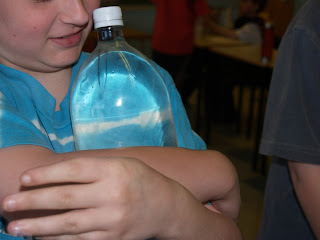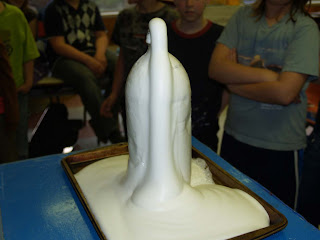I've been in a debate these last few days over multiplication tables. How do you teach them. I've heard from a number of people who say that they need to be memorized. My problem with this is that only a handful of students seem capable of doing this and with less time being spent studying at home this numbeer is getting smaller.
Students who are not successful in memorization are lost when memory fails. The student who forgets 4 x 6 makes no effort to solve this problem. He has failed.
I think that students need to be taught to recognize patterns. Then, when memory fails the real math begins.
"I don't know 4 x6 but 2 x 6 is 12 so if I double 12.."
" I don't know 4 x 6 but I know you can halve and double so 4 x6 is the same as 2 x 12 or 3 x 8 ."
Pentz Patterns in Math Name ______________________
2 x 3 = _______ 4 X 3 = ______
2 x 4 = _______ 4 x 4 = ______
2 x 9 = ______ 4 x 9 = ______
2 x 5 = ______ 4 x 5 = ______
2 x 8 = ______ 4 x 8 = ______
2 x 6 = ______ 4 x 6 = ______
2 x 7 = ______ 4 x 7 = ______
2 x 2 = ______ 4 x 2 = ______
2 x 1 = ______ 4 x 1 = ______
2 x 0 = ______ 4 x 0 = ______
Thursday, October 22, 2009
Wednesday, September 16, 2009
Number Patterns
I'm subbing 2 days for a grade5/6 class next week. The class is doing number patterns in math and I was looking for something fun to do with fibonacci numbers. Most online activities say the numbers are 1 1 2 3 5 8 13 21 etc. and they are very common in nature. Go out and find them. I spend a lot of time outdoors and I know a lot of plants like clover have 3 leaves and many flowers have 5 petals but there are a lot of plants out there that don't seem to fit.I think it may be interesting to us some cube links or other blocks to build a pattern. We can use calculators to divide. 5/8 = 0.625 8/13 = etc. Has anybody done anything with these numbers ?
Web Sites
Cyclic Number (gr.5,6)
Calendar Math (gr.2 -6)
Function Machine
Fibonacci Numbers and Nature
Fibonacci in Nature (pictures)
Math is Fun Fibonacci
Number Cracker
Pine Tree number Patterns
Interactive Hundred Square
Shape Pattern Prediction Version 1
Web Sites
Cyclic Number (gr.5,6)
Calendar Math (gr.2 -6)
Function Machine
Fibonacci Numbers and Nature
Fibonacci in Nature (pictures)
Math is Fun Fibonacci
Number Cracker
Pine Tree number Patterns
Interactive Hundred Square
Shape Pattern Prediction Version 1
Thursday, May 7, 2009
Wednesday, April 29, 2009
Cartesian Diver


Students need to use large container filled with water to float glass medicine dropper.
Have them adjust amount of water so that dropper just floats. In dropper shown 1 ml. of water works well.
Place the dropper in the bottle , tightly close lid and squeese the bottle with two hands. The pressure contracts the water in the dropper allowing more water to enter the dropper.
Friday, April 24, 2009
Inertia

I have a number of science demos that I like to do with elementary students. Some require a little practice or prep time but you soon become confident with them.
I have never had a problem with this demo and have done it dozens of times but I still expect the glasses to go crashing to the floor.
We begin with a discussion of Sir Isaac Newton. There always seems to be one or two students who claim to have heard of him . I have been scared to ask how or where. I talk a little about gravity and the Law of Inertia.
An object at rest tends to stay at rest and an object in motion tends to stay in motion with the same speed and in the same direction unless acted upon by an unbalanced force.
I mention pulling someone on a sled and how you have to use more energy to get the sleigh moving although sleds and toboggans are probably as rare today as hearing about 17th century physicists .
Then we count to 3 and I smash the stick.
Here are a few tips:
1. Originally, I saw this done with pins at the ends of the stick. I don't use them anymore and don't have to worry about losing them. ( I always thought the pins were cheating a bit.)
2. Do not let your significant other catch you using or even looking at the best crystal.
You can pick up some nice wine glasses at most dollar stores. Make sure you use wine glasses because regular drinking glasses don't have the same effect.
Tuesday, April 21, 2009
Land and Water

What percentage of the Earth is land?
Discuss names of continents and oceans with students.
Use an inflatable globe .
Designate 5 or 10 students as Catchers and position them around the room.
Assign an equal number as Markers. They record
name______
Land ____ Water ____
on the classroom board.
Assign other students as Checkers. They will verify if the Catchers right thumb is on land or water.
Toss ball to first Catcher.
The
Catcher and Checker tell the Marker whether the Catcher's right thumb is on land or water.
The Catcher tosses the globe to the next Catcher.
After 10 tosses you will have recorded 50 or 100 catches. This will give you an estimate of how much of the Earth is covered with salt water.
Monday, April 13, 2009
Amphibians
Friday, March 27, 2009
Chromatography



Today we worked at chromatography at Petite. Use coffee filters or paper towel to break apart secondary colours. Using water soluble markers, place two dots on your paper. Then place the paper in a glass of water so that the water wicks up the paper and and seperates the ink into its different dyes.
You can also test kool-aid to see which kinds of dyes have been used.
Thursday, March 5, 2009
Long Division

I have just added a page to my web site on long division. I not certain what the method on the left is called but find it a vast improvement over the method we were taught in school.
This method may require more steps but it is much easier to understand.
Let's look at the problem . Imagine I am dividing 789 widgets among 9 people.
Students can do long division without knowing all their times tables.
I can solve any problem if I know my 1,2,5, and 10 times tables. I start by giving each person 50 widgets, then 20, 10 etc.
The problem can be solved in all manner of ways.
I can start by giving each person 70 widgets or I could give them 10 widgets 7 times.
Monday, March 2, 2009
Right Handed Cat?
Monday, February 23, 2009
Mini Lesson Feb.23
Multiples of Nine.
Here is a website that is worth checking out.
> http://www.regiftable.com/RegiftingRobinPopUp.html
You are asked to pick a 2 digit number and then subtract those 2 digits from your number. ex. you choose 48 and subtract 4 and 8 from it. Your number is 36
You then find your number on a page of numbers and a matching gift.
The computer then tells you the exact gift you chose.
How?
Have the class solve the problem. Have each student choose a number and subtract the two digits. List the numbers.
36, 45, 81, 18, 27
Do you see a pattern?
3+6, 4+5, 8+1
Now take a second look at the gift page. What is listed for 9, 18, 27, 36....?
Here is a website that is worth checking out.
> http://www.regiftable.com/RegiftingRobinPopUp.html
You are asked to pick a 2 digit number and then subtract those 2 digits from your number. ex. you choose 48 and subtract 4 and 8 from it. Your number is 36
You then find your number on a page of numbers and a matching gift.
The computer then tells you the exact gift you chose.
How?
Have the class solve the problem. Have each student choose a number and subtract the two digits. List the numbers.
36, 45, 81, 18, 27
Do you see a pattern?
3+6, 4+5, 8+1
Now take a second look at the gift page. What is listed for 9, 18, 27, 36....?
Wednesday, February 11, 2009
February Update.

Hi, Hope everyone is doing well.
I have been working on a couple math topics that I hope you will find useful.
Symmetry
In math I have added a symmetry page that has a number of activities for different grade levels. I had some help from the Grade 6 class at Petite.
T Rex Math
I have reworked the TRex math page. I really think that counting in Base 4 or Base 2 exercises will help students who are having difficulty with Base 10.
Google Earth
While working on the area and perimeter page I stumble on a short Youtube video on using Google Earth. Find your school or a large building on Google Earth and then Tools, select your unit of measurement and you can get the dimensions of the building.
Science Shorts
A couple of things in science. February 12 is Darwin's birthday. On my Schedule page you can link to a free Gizmo that shows how climate change can effect the shape of a bird's beak.
We haven't had to many clear evenings but the planet Venus continues to dominate the early evening sky.
Remember to check the Science News. It is updated weekly.
Thanks for your time,
John
Friday, January 30, 2009
Faded 89
Tuesday, January 20, 2009
Fraction Man Part Two
Today I was subbing for a Grade 2 class. They were doing fractions in math and I noticed that there were 16 students in the class. We talked about a set of fractions. We divided the class into 2 groups of 8 and ttalked about 1 group bieng 1/2 of the class. Then we divide the class into 4 groups and finally 8 groups.
Then we looked at fractions of area. Each student took a piece of paper and we folded and unfolded it looking at halves, quarters, eighths and sixteenths.
Then the class made 2 fraction men. We divided up the tasks and I was very pleased with the results.
Then we looked at fractions of area. Each student took a piece of paper and we folded and unfolded it looking at halves, quarters, eighths and sixteenths.
Then the class made 2 fraction men. We divided up the tasks and I was very pleased with the results.
Sunday, January 18, 2009
Monday, January 5, 2009
Equivalent Fractions
quarters
Sunday, January 4, 2009
Grade 5 Fraction interviews
January 3 Today I spent some time working on interview questions. To see if the student understands fractions on a number line ask them to show you 0.5m. , 0.25 m and 0.755m on a meter stick.
Using pen and paper ask a student to add 0.4 and 3.
On a piece of graph paper, ask the student to draw a 3x 5 rectangle and shade in 1/3.
Using pen and paper ask a student to add 0.4 and 3.
On a piece of graph paper, ask the student to draw a 3x 5 rectangle and shade in 1/3.
Saturday, January 3, 2009
Penny Fractions
Subscribe to:
Comments (Atom)














